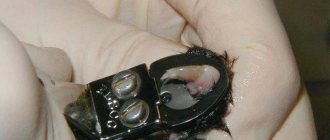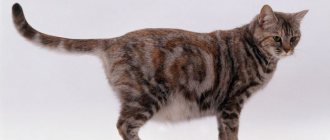What is the disease
This disease occurs exclusively in cats and affects the pads of their paws. This passes painlessly, the pads seem swollen and enlarged, but the general condition of the animal is satisfactory, most often without changes, so pododermatitis in the initial stages can go unnoticed, especially if the animal leads a free lifestyle and has the opportunity to walk freely, or if there are several cats .
Some animals may experience lymphadenopathy - enlarged lymph nodes, while others do not react at all to the development of pododermatitis. The toe pads are very rarely affected; most often the main pad of the foot or part of it is affected.
Dermatitis can occur on one paw, on several paws, or be diagnosed on all four paws. The stages of the disease can be completely different, from barely noticeable swelling to severe swelling with complications in the form of a secondary infection.
With the long-term development of the disease, the pads become greatly enlarged and inflamed, and if the integument is damaged and infection occurs, they can fester, turn blue and become covered with purulent crusts. As inflammation develops, the cat may limp on one leg, or if more limbs are affected, it will be noticeable that it is inconvenient and uncomfortable for him to move, the animal will try to lie down more.
All cats are equally susceptible to this disease - kittens, young, old, purebred and crossbreeds, domestic and stray. It doesn’t matter if it’s a cat or a female cat—any animal can get hurt.
Causes of limb failure
The occurrence of weakness in a cat's hind legs is caused by a large number of different factors. The main ones include hip dysplasia, hyperparathyroidism, thromboembolism, and inflammatory processes in the spinal cord.
Falls from great heights are often the cause of hind limb failure in cats. There is an opinion that representatives of the cat family perfectly group while jumping, landing on their paws. In fact, this is a myth that is far from the truth. Quite often in the practice of veterinarians there are cases of injuries to the spine, especially the sacral region in cats, resulting from a fall from a height.
When falling from a balcony, roof or tree, there is a high risk of damage to the lumbar spine, affecting the nerve endings responsible for the functioning of the hind limbs, tail and internal organs located in the back.
It is important to promptly determine the cause of lameness, as it can develop as a result of paralysis or a fracture of the cat’s hind leg. Treatment and diagnosis will have significant differences.
Other causes of hind limb paralysis are:
- Intervertebral disc herniation. With this pathology, the intervertebral disc protrudes, causing the animal severe pain. Disc displacement between the vertebrae leads to compression of the nerve endings of the spinal cord and blood vessels. There is a disruption in the transmission of impulses along nerve fibers to the brain, necessary for the physiological functioning of the hind limbs.
- Thromboembolism. A disease characterized by the development of blood clots in the area of the femoral artery, blocking the lumen, disrupting blood flow and trophism of nearby tissue structures. An embolus, by its designation, is a solid, liquid or gaseous substrate inside a vessel that does not occur under normal conditions. An embolus can be a particle of a neoplasm, a parasitic microorganism, or a blood clot. If a cat drags its hind paw, experiences severe pain, and sensitivity decreases, then the chances of recovery are quite slim.
- Inflammatory processes in the spinal cord. Inflammation in the spinal cord can be triggered by infection of the body with worms, autoimmune diseases, and intoxication with heavy metal salts. The clinical picture of inflammation of the spinal cord is expressed by a sharp deterioration in the pet’s general condition, an increase in body temperature to high levels, dehydration and urinary incontinence.
- Stroke. Rarely occurring, but nevertheless giving serious consequences for the whole organism, is a pathological condition of the brain. As a result of hemorrhage and depending on the degree of vascular damage, paralysis of the hind limbs may develop in pets. Treatment of diagnosed stroke in cats involves taking immediate measures to stabilize the general condition of the body. In the absence of qualified assistance, the consequences are unusually severe, and death is also possible.
- Hyperparathyroidism of nutritional origin. Due to disturbances in metabolic processes in the body due to a lack of vitamin D and calcium, as well as as a result of increased phosphorus content, disturbances in the functioning of the parathyroid gland occur. Excessive amounts of parathyroid hormone are produced, and the gland itself works under increased load. In an animal with alimentary hyperparathyroidism, the bone structures are disturbed, the cat limps on its hind legs, convulsive phenomena are diagnosed, a shaky gait is detected, the paws move in different directions when walking. Timely diagnosis and treatment makes it possible to completely rid your pet of the disease.
Causes of dermatitis
At the moment there is no exact data on the cause of the disease. Many veterinarians believe that plasmacytic type pododermatitis is a peculiar reaction of the body to some external or internal influences.
It is believed that this disease occurs as a response of the immune system to various factors, that is, dermatitis itself is a skin reaction, a symptom of a problem that has arisen due to the inappropriate behavior of the animal’s immune system. Perhaps this explains the cases of spontaneous cure of the disease.
Symptomatic picture
The signs of the disease are quite eloquent - the cat’s paw pads become very swollen due to the penetration of plasma cells into the tissue. If the pads are light, then it is noticeable that they change their shade to a brighter pink with a lilac or bluish tint; on black or other dark paws, the change in color is not so noticeable or not visible at all, but severe edema, literally swelling of the pad, is always observed.
When you feel the swollen paw pads, the cat does not react, that is, the formations are not painful, but severe swelling can prevent the animal from walking normally, causing inconvenience or discomfort. Peeling of the surface of the affected pad is often observed. But with severe swelling of the tissue, the pads cannot withstand the tension and crack.
Infection penetrates into the lesions, which leads to inflammation and the appearance of purulent foci. The skin becomes covered with sores that bother the animal; the cat can constantly lick them, which can cause the spread of bacterial infection and lead to lameness of the pet.
A particular threat is posed by open damage to the tissues of animals that live in a private house and have free access to the street and the ground. If such a complication of the disease occurs, you need to keep the cat in a closed, clean room.
In some cases, the disease suddenly disappears on its own without any specialized treatment or stable remission occurs.
Caring for cat paw pads
Contents hide
Some cat lovers looked at the title and were quite surprised: caring for paw pads? We hear the opinion that a healthy cat is quite capable of keeping its body clean, and its paw pads are no exception. Indeed, any cat lover watches with pleasure how his pet carefully moistens the pad with saliva and removes debris that accidentally gets between its fingers. Is it really necessary to help him?
Experts are inclined to give a positive answer - yes, it is necessary. Especially when you let your pet go outside. Cats are famous travelers, wherever they go. Whiskered animals walk, run, climb and jump a lot, and at the same time they touch not only soft carpets with their paws. Cuts, irritations, and foreign objects caught between the toes and causing discomfort are not uncommon.
And it’s not a sin to look after domestic cats. Are you sure the product you use to mop your floors or clean your furniture is pet-friendly? And cats walk on these surfaces, and then lick their paw pads with their tongues, the “chemistry” enters the body. The animal suddenly fell ill, and you (and your treating veterinarian) are completely at a loss as to what happened and what to treat it for. Quite often, completely unnecessary drugs are prescribed “for prevention” and are intended to treat completely different diseases.
We hope we managed to convince readers: you still need to wash the paws of your mustachioed friends. Maybe not every day, but from time to time, as needed. Our recommendation is especially relevant for cats in mixed housing.
What is "from time to time"? Each owner decides for himself. Suppose that upon returning from the street, your pet has a hearty lunch, and then decides to jump onto the owner’s lap, cuddle him, and at the same time wash himself. Don’t get lost: while stroking and scratching your pet, discreetly take the paw in your hand and inspect the condition of the paw itself and the pad. Many things should alert you: a cracked surface, blood, pus on the surface or between the fingers, suspicious lumps, tubercles and other compactions, wounds, cuts and other points. Let’s call them conventionally: “This didn’t exist before, and suddenly it appeared.” We won’t give a lecture on the anatomy of a cat’s paw, but let one main recommendation remain in your subcortex: vigilance has never harmed anyone. It is better to let the alarm turn out to be false than to subsequently have to treat an advanced disease. Fungus, skin cancer, and other dangerous and insidious ailments - all this occurs in our furry pets.
What do we have to do? Friends, we don’t want to “cause fear” and exaggerate things. In the vast majority of cases, the most ordinary, routine procedures will suffice. Take a clean and soft cloth (it’s better to immediately make several rags-towels), soak it in warm water and gently wipe the pad and the space between your fingers. If the pad is dry and cracked, use special moisturizing wipes, lotion or baby cream. Make sure (or to be sure, consult with your veterinarian) that the products used are pet-friendly, that is, safe for the animal. You can use a baking soda solution. If your cat walks on sidewalks that are heavily sprinkled with salt or deicing agents, add a drop of vinegar to the solution.
It should be emphasized that you need to work with your pet in a positive manner, in a great mood. Never use force or hold your pet. On the contrary, many cats love and appreciate a relaxing paw massage and purr with great pleasure during the process. At the same time, we advise you to take out special scissors and trim the claws a little. And don't forget about homemade scratching posts. Let there be many of them, good and different.
Material used: Should You Clean Your Cat's Paws? Author: Susan Dorling. Source: cuteness.com Photo:
Diagnostic features
A picture similar to plasmacytic pododermatitis can be observed in the following diseases:
- Eosinophilic granuloma.
- Neoplasia.
- Pemphigus foliaceus.
- A splinter or other type of injury to the pad by a foreign object.
Neoplasia is the formation of new tissue, that is, in fact, the development of a tumor - benign or malignant. With eosinophilic granuloma, the spaces between the animal's toes are affected, the cat suffers from severe itching, tries to lick and even bite the sore spot.
The paw pads are not only swollen, but also very inflamed and red, with the toe pads being more affected, which distinguishes this disease from plasmacytic pododermatitis.
Pemphigus foliaceus is characterized by damage to the finger pads, and not the main pad, as in pododermatitis, swelling is much less pronounced or absent altogether, yellowish crusts or peeling form on the finger areas.
Injury by a foreign object does not occur on all or several paws at once; it is usually not accompanied by severe swelling, but more like an abscess.
Due to the fact that various diseases can appear with similar symptoms, the most accurate result will be provided by diagnosis using cytological or histological examination.
Signs of limb failure
Cuts to the hind limbs in cats, as well as paralysis, have a fairly clear clinical picture. The owner may notice that the cat drags one or both hind legs, the gait becomes unsteady (shaky), and pain occurs when leaning on the hind leg and when walking.
When characteristic symptoms of paralysis of the hind limbs appear, the owner’s task is to take a close look at the general behavior of his pet.
The main signs of paresis or paralysis of the paws are:
- unsteady, unsteady gait affecting the back of the body;
- delay in making movements, loss of balance;
- weakness in the cat’s hind legs (the limbs may move apart, and after a while they fail);
- constant squatting on the hindquarters (not completely), as a rule, is observed in older animals;
- dragging of the hind limbs, which is characterized by not lifting them off the floor when walking;
- decreased overall mobility.
Any of the above symptoms indicates disorders in the musculoskeletal system and requires immediate diagnostic measures. There are many reasons that provoke a condition in which a cat’s hind legs become entangled.
Delay in diagnosis and self-medication only aggravate the animal’s condition, causing it significant discomfort and severe pain.
Treatment of the disease
If the cat does not suffer from the disease, and it has mild manifestations, does not interfere with the animal’s ability to move normally and does not threaten inflammation or the appearance of ulcers, then there is no need to rush into medical treatment. Usually the animal is monitored, and if threatening symptoms appear or the course of the disease becomes more complicated, the necessary measures are immediately taken.
But in the absence of the development of the disease, the cat is simply provided with comfortable conditions, fed well and balanced, and provided with peace, warmth and love from the owners. Since there is a tendency for the disease to disappear on its own, such a wait-and-see attitude may turn out to be correct, rational and useful.
If the disease develops or the affected area is too large, affects several or all paws, and prevents the animal from walking, then the following treatment is prescribed:
- Systemic glucocorticosteroids (Prednisolone, Methylprednisolone) in a gradually decreasing dosage. That is, a loading dose of 2–4 mg per kg of animal weight is first prescribed 1–2 times a day, and then this dosage is gradually and constantly reduced until the drug is completely discontinued.
- Antibiotics for secondary infections, for example, Doxycycline at a dosage of 10 mg per kg of cat weight once a day for 1 - 1.5 months.
- Cryotherapy is treatment with cold and freezing.
- Vitamin E at a dose of 50 mg per day sometimes has a very good effect.
- Surgical excision of the changed area of the pad.
Any of the listed medications or treatment methods can have a healing effect and cure the disease. Surgical removal of the affected tissue leads to the disappearance of feline plasmacytic pododermatitis without additional exposure to drugs.
It is important for cat owners to closely monitor their pets and regularly examine them, not forgetting about their paws. Increased attention will allow you to pay attention to a possible disease at the earliest stages and begin treatment on time.
Causes and risk factors
Until now, the exact root causes of this disease of cat paws have not been clarified. It is assumed that the trigger for the development of pathology may be a decrease in immunity and activation of opportunistic microflora. This includes various types of bacteria and fungi. While the immune system copes with the load, microorganisms are in a latent state, but at the slightest failure they are activated, causing various diseases, including pododermatitis.
Another suspected reason is negative environmental factors. Diseases of the paws and fingers often appear on cold days when there is severe frost outside. In such conditions, the paw pads freeze, peel, and then crack. Often contact with chemicals used to combat snow and ice causes wounds on unprotected pads. The sore can also occur due to the introduction of a strong allergen into the cat’s body. A.N. Gehrke, Ph.D., veterinary dermatologist, suggests that feline plasmacytic pododermatitis may begin to progress against the background of autoimmune disorders (vetpharma.org/articles/66/4787/). However, such a pathology is difficult to diagnose, so often the original source of the disease becomes unclear.
The risk group for developing this pathological process includes all breeds of cats, regardless of age and environmental conditions.










